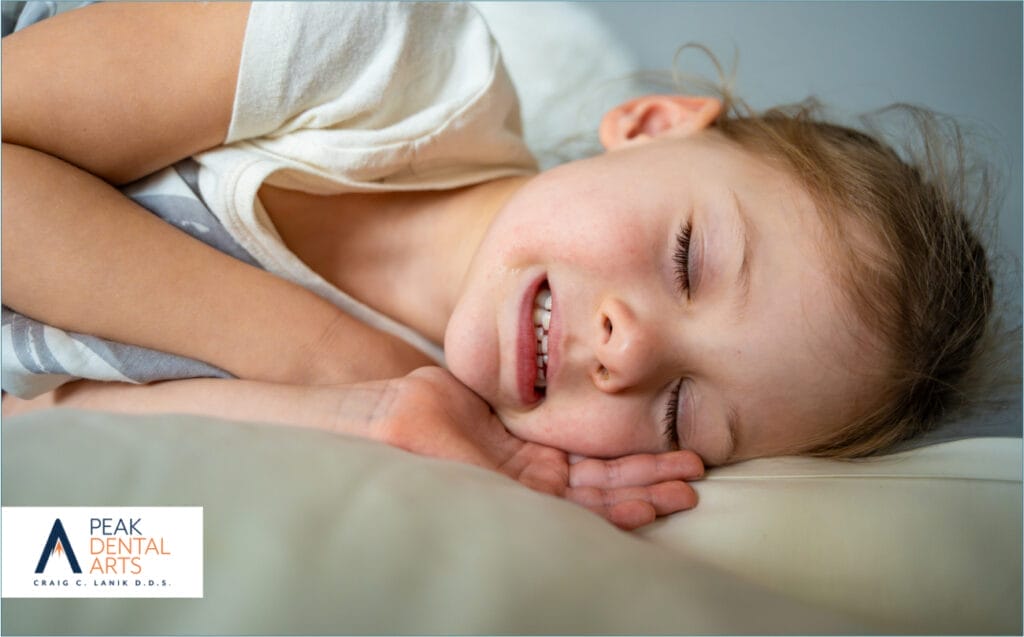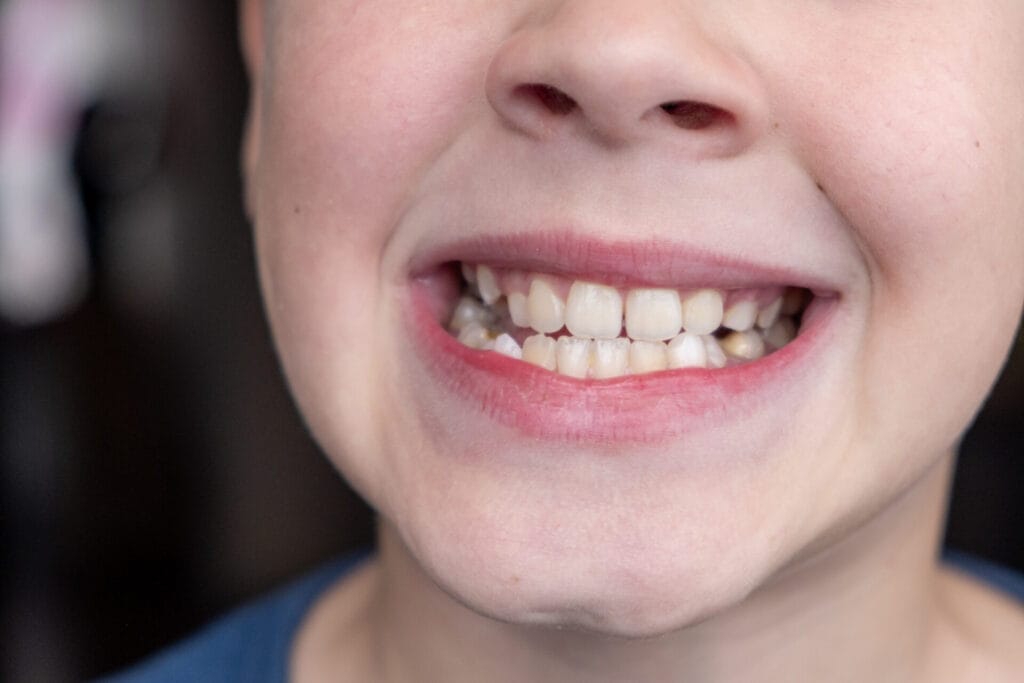Have you ever peeked in on your sleeping child only to hear an unsettling grinding sound coming from their mouth? That distinctive noise—often described as teeth gnashing or clenching—is likely bruxism, and it’s more common in children than many parents realize. As a parent, few things are more concerning than discovering your child has a health issue you weren’t aware of, especially one that occurs while they’re sleeping.
Let’s explore what exactly this condition is, why it happens, and most importantly, what you can do about it.

Understanding Childhood Bruxism
Bruxism is the medical term for the habitual grinding, gnashing, or clenching of teeth. This condition can occur during the day (awake bruxism) but is most common during sleep (sleep bruxism). In children, sleep bruxism is particularly prevalent, affecting up to 20-30% of kids at some point during childhood. While many children eventually outgrow this habit, understanding the condition is crucial for managing it effectively and preventing potential complications.
Common Causes
So why do children grind their teeth in the first place? The causes of bruxism in children are multifaceted and often interconnected. One of the most common triggers is stress or anxiety. Just like adults, children process their emotions in various ways, and teeth grinding can be a physical manifestation of psychological tension. School pressures, family changes, or social challenges can all contribute to this stress response. Children who are naturally more anxious or who have trouble processing emotions may be more susceptible to bruxism.
Physical factors also play a significant role in childhood bruxism. Misaligned teeth or an abnormal bite (malocclusion) can lead to grinding as the body subconsciously tries to correct the imbalance. Additionally, some medical conditions have been linked to increased instances of teeth grinding in children. These include attention-deficit/hyperactivity disorder (ADHD), certain medications, and even allergies or airway issues that might cause sleep disturbances.
Interestingly, there may also be a hereditary component at play. If you or your partner experienced bruxism as a child, your little one might be more likely to develop it too. Research done by the National Library of Medicine suggests that genetics can influence both the likelihood of developing the condition and how a child responds to various treatment approaches.

Recognizing the Signs
Recognizing the signs of bruxism in your child is the first step toward addressing it. The most obvious symptom is, of course, the audible grinding or clicking sounds during sleep. If you hear these noises coming from your child’s room at night, it’s worth investigating further. However, not all children will grind loudly enough for parents to hear, so it’s important to be aware of other potential indicators.
Does your child complain of jaw pain or headaches, particularly in the morning? These could be signs that they’ve been clenching or grinding their teeth during the night. Morning facial soreness or difficulty opening the mouth widely might also point to bruxism. In more severe cases, you might notice wear on your child’s teeth—flattened tips, chips, or even exposed dentin (the layer beneath the enamel). Regular dental check-ups are important for catching these signs early, as your dentist will be able to spot wear patterns that you might miss.
Potential Complications
While occasional teeth grinding may not cause significant problems, chronic bruxism can lead to several complications if left unaddressed. The constant pressure and friction can wear down tooth enamel, potentially leading to increased sensitivity and a higher risk of cavities. In severe cases, teeth may become cracked, chipped, or fractured. The jaw muscles and joints can also be affected, potentially resulting in temporomandibular joint disorders (TMD) that cause pain and limited jaw movement.
Beyond the physical impact, bruxism can affect your child’s sleep quality. The grinding itself might wake them up, or the condition might be associated with other sleep disturbances. Poor sleep can have wide-ranging effects on a child’s mood, behavior, and academic performance, making it all the more important to address bruxism promptly.
Diagnosis and Evaluation
If you suspect your child might be grinding their teeth, the first step is to consult with their dentist. A thorough examination will help determine whether bruxism is present and assess any damage that may have occurred. The dentist might ask about your child’s medical history, medications, and daily routine to identify potential triggers. In some cases, they might refer you to a sleep specialist or other healthcare provider for further evaluation.

Treatment Approaches
The good news is that many children naturally outgrow bruxism as they develop, particularly if it’s linked to developmental factors like the transition from baby teeth to permanent teeth.
However, there are several approaches you can take to manage the condition in the meantime and prevent complications.
Managing Stress and Anxiety
For mild cases where stress seems to be the primary trigger, lifestyle modifications may be sufficient. Establishing a calming bedtime routine can help your child unwind before sleep. This might include warm baths, gentle stretching, reading together, or practicing deep breathing exercises. Limiting screen time before bed is also beneficial, as the blue light from devices can interfere with sleep quality and potentially exacerbate grinding.
If your child’s bruxism appears to be stress-related, addressing the underlying anxiety is crucial. Open conversations about their worries, teaching healthy coping mechanisms, and ensuring they have adequate outlets for their emotions can all help reduce teeth grinding.
For some children, professional support from a child psychologist or counselor might be beneficial, particularly if the anxiety is severe or persistent.
Dental Interventions
When bruxism is causing significant tooth wear or pain, your dentist might recommend a custom-fitted night guard. These appliances create a barrier between the upper and lower teeth, preventing grinding damage. While they don’t necessarily stop the grinding itself, they do protect the teeth from further wear. For younger children, these devices are typically designed to accommodate growing mouths and may need to be replaced periodically.
Addressing Underlying Medical Conditions
In cases where bruxism is linked to medical conditions or medications, working with your child’s healthcare provider to manage these underlying factors is important. Sometimes, simple adjustments to medication timing or dosage can make a difference. If breathing issues or allergies are contributing to the problem, addressing these conditions may help reduce grinding episodes.
Related Article: The Best Age-Based Dental Care Tips for Growing Families
Supporting Your Child
Remember that bruxism is generally not a reflection of parenting or a sign that something is seriously wrong with your child. It’s a common condition that, with proper management, typically doesn’t lead to long-term problems. The key is awareness and appropriate intervention when needed.
As a parent, maintaining open communication with your child about what they’re experiencing is invaluable. Explain bruxism in age-appropriate terms and reassure them that they’re not doing anything wrong. Involve them in the management process—whether it’s practicing relaxation techniques together or helping them remember to wear their night guard—to give them a sense of control over their condition.
If you notice your child grinding their teeth, don’t hesitate to seek professional advice. Your dentist and pediatrician are your allies in ensuring your child’s oral health and overall well-being. With proper attention and care, your little one can sleep soundly—and so can you, knowing that you’re taking the right steps to protect their precious smile.

